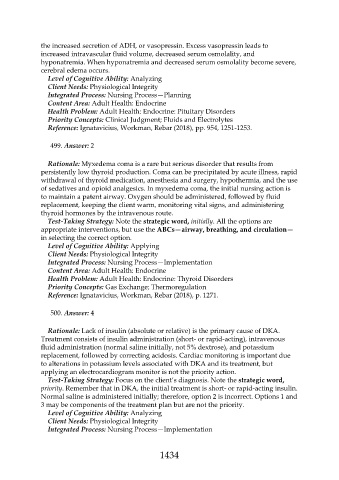Page 1434 - Saunders Comprehensive Review For NCLEX-RN
P. 1434
the increased secretion of ADH, or vasopressin. Excess vasopressin leads to
increased intravascular fluid volume, decreased serum osmolality, and
hyponatremia. When hyponatremia and decreased serum osmolality become severe,
cerebral edema occurs.
Level of Cognitive Ability: Analyzing
Client Needs: Physiological Integrity
Integrated Process: Nursing Process—Planning
Content Area: Adult Health: Endocrine
Health Problem: Adult Health: Endocrine: Pituitary Disorders
Priority Concepts: Clinical Judgment; Fluids and Electrolytes
Reference: Ignatavicius, Workman, Rebar (2018), pp. 954, 1251-1253.
499. Answer: 2
Rationale: Myxedema coma is a rare but serious disorder that results from
persistently low thyroid production. Coma can be precipitated by acute illness, rapid
withdrawal of thyroid medication, anesthesia and surgery, hypothermia, and the use
of sedatives and opioid analgesics. In myxedema coma, the initial nursing action is
to maintain a patent airway. Oxygen should be administered, followed by fluid
replacement, keeping the client warm, monitoring vital signs, and administering
thyroid hormones by the intravenous route.
Test-Taking Strategy: Note the strategic word, initially. All the options are
appropriate interventions, but use the ABCs—airway, breathing, and circulation—
in selecting the correct option.
Level of Cognitive Ability: Applying
Client Needs: Physiological Integrity
Integrated Process: Nursing Process—Implementation
Content Area: Adult Health: Endocrine
Health Problem: Adult Health: Endocrine: Thyroid Disorders
Priority Concepts: Gas Exchange; Thermoregulation
Reference: Ignatavicius, Workman, Rebar (2018), p. 1271.
500. Answer: 4
Rationale: Lack of insulin (absolute or relative) is the primary cause of DKA.
Treatment consists of insulin administration (short- or rapid-acting), intravenous
fluid administration (normal saline initially, not 5% dextrose), and potassium
replacement, followed by correcting acidosis. Cardiac monitoring is important due
to alterations in potassium levels associated with DKA and its treatment, but
applying an electrocardiogram monitor is not the priority action.
Test-Taking Strategy: Focus on the client’s diagnosis. Note the strategic word,
priority. Remember that in DKA, the initial treatment is short- or rapid-acting insulin.
Normal saline is administered initially; therefore, option 2 is incorrect. Options 1 and
3 may be components of the treatment plan but are not the priority.
Level of Cognitive Ability: Analyzing
Client Needs: Physiological Integrity
Integrated Process: Nursing Process—Implementation
1434

